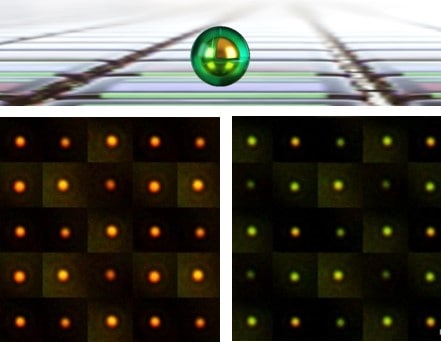 Top: an eNPoM, which changes colour as a function of redox state of the thin (0 to 20 nm) polyaniline shell surrounding each gold nanoparticle on a gold mirror substrate. Bottom: experimental dark-field scattering images of a single eNPoM nanopixel for different redox states of the polymer shell. Courtesy: J Baumberg, NanoPhotonics Centre at the Cavendish Laboratory, University of Cambridge
Top: an eNPoM, which changes colour as a function of redox state of the thin (0 to 20 nm) polyaniline shell surrounding each gold nanoparticle on a gold mirror substrate. Bottom: experimental dark-field scattering images of a single eNPoM nanopixel for different redox states of the polymer shell. Courtesy: J Baumberg, NanoPhotonics Centre at the Cavendish Laboratory, University of Cambridge
Large-scale plasmonic metasurfaces could find use in flat panel displays and other devices that can change colour thanks to recent work by researchers at the University of Cambridge in the UK. They have developed a new, simple, bottom-up technique to fabricate colour-changing nanostructures made from metallic nanoparticles and conducting polymers.
As metallic particles become smaller in size, phenomena such as surface plasmons appear. These are collective excitations of electrons at the surface of a metal that very strongly interact with light. This light-matter interaction is strongest at the plasmon-resonance frequency, which is defined by the size and shape of an object and its charge density. Applications such as sensing, imaging, actuation and displays can exploit these resonances.
Displays are a particularly interesting application since researchers can now use advanced nanolithography techniques to make plasmonic building blocks capable of producing a wide range of colours while keeping the overall size of the blocks smaller than the pixels employed in commercial displays. However, the problem is that the colour of these devices is static and cannot be easily tuned.
NPoM pixel
One way of overcoming this challenge is to make a multi-layered plasmonic composite structure filled with a dielectric spacer. The key feature in this structure, known as the nanoparticle-on-mirror (NPoM) pixel, is that closely separated metal nano-objects strongly confine light within their individual gaps to the underlying mirror and thus produce extremely localized cavity resonances, explain the researchers. This makes them insensitive to the angle and polarization of incoming light, which means they can be used to create nanoscale pigments for display applications. The main difficulty here, however, is to be able to produce NPoMs on a large scale while ensuring that each individual NPoM acts as an independent nanopixel.
A team led by Jeremy Baumberg of the NanoPhotonics Centre at the Cavendish Laboratory has now done just this using a bottom-up solution process. The researchers chemically coated gold nanoparticles in water with a thin layer of the conducting polymer polyaniline. They then sprayed these particles onto a metallic mirror where the small nanogap below each nanoparticle is filled by the polyaniline film.
The electrochromic NPoM works by switching the charge state of the entire polyaniline shell (by oxidizing and reducing it in an electrochemical cell), thus shifting the resonant scattering colour of the eNPoM across a wavelength range that is greater than 100 nm.
Stable colour state
“The nanogap below each nanoparticle is in fact dependent on the thickness of the polymer coating and we can exquisitely control this thickness on the nanoscale when we grow it around the gold particles,” explains team member Hyeon-Ho Jeong. “We are not only limited to polyaniline in this technique and a whole range of different polymers can be used.”
The active nanopixel in the device only requires about 0.2 femtojoules of energy for each 1-nm shift in wavelength, he adds. What is more, once the state of the polymer has been electrically switched it stays that colour for a long time, so no further power is needed to maintain the pixel in that colour.
“Since the state of the polymer controls the reflected colours of light, the devices don’t need a backlight (though you can’t see them in the dark),” he tells Physics World. “These structures could thus be used to help drastically reduce the power required for large-area displays. The fact that we can already switch at rates greater than 50 Hz means that video displays might even be possible.”
Early days
The researchers say that it is still very early days for their technology, but that they are making great progress. “We are now trying to fabricate pixel-array demonstrators,” says Baumberg, “and looking for partners to develop our work further. One area we are especially interested in is making buildings silvery to reflect sunlight on a hot summer’s day and black to absorb solar radiation on duller days, thus reducing building heating requirements.”
Read more

Surface plasmons reveal their secrets
According to the researchers, other potential real-world applications include colour-changing wallpapers, smart windows, traffic management systems, electrical signage, display panels and even cars that change colour. “What if your car could blush?” asks Baumberg. “Would that change how we deal with road range and allow us express ourselves differently?”
Apart from colour displays, the plasmonic colour-changing metasurfaces might also be used in flexible and wearable sensing, he adds, since the optical properties vary according to changes in electrical charge as well as pH (proton density). The technology might also be used in fundamental studies to measure hot electron generation and photochemistry on extremely small length scales in real time.
The researchers, who detail their work in Science Advances 10.1126/sciadv.aaw2205, say they are now busy trying to understand what controls the charge leakage from the polymers, because they would like them to stay in their colour state for as long as possible. “We are also aiming to make a better blue colour and see if we can achieve a full colour gamut,” reveals Baumberg.

